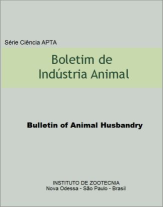Respostas morfogênicas e estruturais de plantas tropicais submetidas à desfolhação
DOI:
https://doi.org/10.17523/bia.v72n4p321Palavras-chave:
morfogênese, características estruturais, perfilhamento, interceptação luminosa, métodos de pastejo.Resumo
A emissão de folhas, seu alongamento e a estrutura que conferem ao dossel forrageiro, são quantificados via morfogênese e característica estrutural do dossel. A emissão e o balanço de perfilhos é conhecido como perfilhamento. Ambos, morfogênese e perfilhamento, conferem ao pasto o potencial produtivo. Este processo é influenciado pela intensidade e a frequência de desfolhação. Pastos apresentam plasticidade fenotípica quando submetidos à pastejo intenso e frequente, com vistas a se adequar a esta condição adversa de ambiente. Ademais, fatores como a idade da planta e adubação influenciam no padrão de crescimento. Uma população com perfil etário jovem, ou um pasto adubado, apresenta taxas morfogênicas mais aceleradas, necessitando de ajustes no manejo do pastejo. Aliados a estes fatos, o padrão sazonal de distribuição de chuvas, temperatura e fotoperíodo, faz com que os pastos tenham padrão de crescimento distinto durante o ano. Quando estas condições são favoráveis ao crescimento das plantas, as taxas morfogênicas são aceleradas e ajustes no manejo são necessários. Sendo assim, o manejo do pastejo na época das águas e na época das secas, são distintos, principalmente por conta de padrões de crescimento diferentes nestas épocas. De fato, vários fatores influenciam o crescimento das plantas em pastejo, todavia, a devida manutenção do índice de área foliar (IAF) do pasto, seja em lotação continua ou lotação intermitente, faz com que resultados satisfatórios sejam obtidos em sistemas de exploração pecuária a pasto. Diante do exposto, metas de manejo considerando parâmetros morfogênicos da planta, aliados à manutenção de IAF adequado, mostram que pastos manejados em lotação continua devem ser mantidos em condições consideradas ótimas tanto para o crescimento da planta como para o consumo animal. Estas condições coincidem com alturas de manutenção de dossel forrageiro, recomendada para cada espécie ou cultivar dentro de espécie. Da mesma forma, em lotação intermitente, a condição ótima de manejo do pastejo, quando a rebrota deve ser interrompida, coincide com o momento em que o dossel forrageiro intercepta 95% da luz incidente, em que a taxa média de acúmulo do pasto é máxima. Sendo assim, o conhecimento das respostas morfogênicas e estruturais de plantas forrageiras em pastejo, frente a mudanças nas condições do meio, auxiliam na tomada de decisão de estratégias do manejo do pasto, com vistas ao uso eficiente do recurso forrageiro.Downloads
Downloads
Publicado
Edição
Seção
Licença
Os autores não serão remunerados pela publicação de trabalhos, pois devem abrir mão de seus direitos autorais em favor deste periódico. Por outro lado, os autores ficam autorizados a publicar seus artigos, simultaneamente, em repositórios da instituição de sua origem, desde que citada a fonte da publicação original seja Boletim de Indústria Animal. A revista se reserva o direito de efetuar, nos originais, alterações de ordem normativa, ortográfica e gramatical, com vistas a manter o padrão culto da língua e a credibilidade do veículo. Respeitará, no entanto, o estilo de escrever dos autores. Alterações, correções ou sugestões de ordem conceitual serão encaminhadas aos autores, quando necessário. Nesses casos, os artigos, depois de adequados, deverão ser submetidos a nova apreciação. As opiniões emitidas pelos autores dos artigos são de sua exclusiva responsabilidade. Todo o conteúdo deste periódico, exceto onde está identificado, está licenciado sob a Licença Creative Commons Attribution (CC-BY-NC). A condição BY implica que os licenciados podem copiar, distribuir, exibir e executar a obra e fazer trabalhos derivados com base em que só se dão o autor ou licenciante os créditos na forma especificada por estes. A cláusula NC significa que os licenciados podem copiar, distribuir, exibir e executar a obra e fazer trabalhos derivados com base apenas para fins não comerciais.













